
Rupee is the common name for the currencies of India, Mauritius, Nepal, Pakistan, Seychelles, and Sri Lanka, and of former currencies of Afghanistan, Bahrain, Kuwait, Oman, the United Arab Emirates, British East Africa, Burma, German East Africa, and Tibet. In Indonesia and the Maldives, the unit of currency is known as rupiah and rufiyaa respectively, cognates of the word rupee.

The sestertius or sesterce was an ancient Roman coin. During the Roman Republic it was a small, silver coin issued only on rare occasions. During the Roman Empire it was a large brass coin.

The eagle is a United States $10 gold coin issued by the United States Mint from 1795 to 1933.
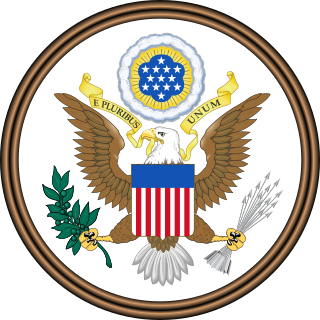
The Coinage Act of 1792, passed by the United States Congress on April 2, 1792, created the United States dollar as the country's standard unit of money, established the United States Mint, and regulated the coinage of the United States. This act established the silver dollar as the unit of money in the United States, declared it to be lawful tender, and created a decimal system for U.S. currency.

The German mark was the currency of the German Empire, which spanned from 1871 to 1918. The mark was paired with the minor unit of the pfennig (₰); 100 pfennigs were equivalent to 1 mark. The mark was on the gold standard from 1871 to 1914, but like most nations during World War I, the German Empire removed the gold backing in August 1914, and gold coins ceased to circulate.

The Egyptian pound is the official currency of Egypt. It is divided into 100 piastres, or qirsh and was historically divided into 1,000 milliemes.
The fineness of a precious metal object represents the weight of fine metal therein, in proportion to the total weight which includes alloying base metals and any impurities. Alloy metals are added to increase hardness and durability of coins and jewelry, alter colors, decrease the cost per weight, or avoid the cost of high-purity refinement. For example, copper is added to the precious metal silver to make a more durable alloy for use in coins, housewares and jewelry. Coin silver, which was used for making silver coins in the past, contains 900 ‰ silver and 100 ‰ copper, by mass. Sterling silver contains 925 ‰ silver and 75 ‰ of other metals, usually copper, by mass.

The Coinage of India began anywhere between early 1st millennium BCE to the 6th century BCE, and consisted mainly of copper and silver coins in its initial stage. The coins of this period were Karshapanas or Pana. A variety of earliest Indian coins, however, unlike those circulated in West Asia, were stamped bars of metal, suggesting that the innovation of stamped currency was added to a pre-existing form of token currency which had already been present in the Janapadas and Mahajanapada kingdoms of the Early historic India. The kingdoms that minted their own coins included Gandhara, Kuntala, Kuru, Magadha, Panchala, Shakya, Surasena, Surashtra and Vidarbha etc.

The rupia was the currency of Portuguese India sometime after 1668 until 1958. Prior to 1668, the currency unit was Xerafim. In 1666, the Portuguese administration struck a silver coin calling it double xerafin and this was declared equal to a rupia in circulation in India outside of Portuguese possessions. A xerafim was a convertible subunit of rupia, and it was unique to Portuguese colonies in India. One rupia equalled two xerafims.

The Austro-Hungarian gulden (German), also known as the florin, forint, or zloty, was the currency of the lands of the House of Habsburg between 1754 and 1892, when it was replaced by the Austro-Hungarian krone as part of the introduction of the gold standard. In Austria, the gulden was initially divided into 60 kreuzers. The currency was decimalized in 1857, using the same names for the unit and subunit.
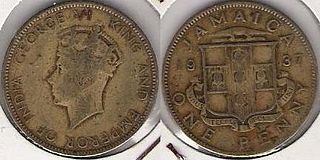
The pound was the official currency of Jamaica between 1840 and 1969. It circulated as a mixture of sterling coinage and locally issued coins and banknotes and was always equal to the pound sterling. The Jamaican pound was also used in the Cayman and Turks and Caicos Islands.

Silver coins are one of the oldest mass-produced form of coinage. Silver has been used as a coinage metal since the times of the Greeks; their silver drachmas were popular trade coins. The ancient Persians used silver coins between 612–330 BC. Before 1797, British pennies were made of silver.

The Netherlands Indies guilder was the unit of account of the Dutch East Indies from 1602 under the United East India Company, following Dutch practice first adopted in the 15th century. A variety of Dutch, Spanish and Asian coins were in official and common usage. After the collapse of the VOC at the end of the 18th century, control of the islands reverted to the Dutch government, which issued silver 'Netherlands Indies' guilder and fractional silver and copper coins until Indonesian independence in 1945.
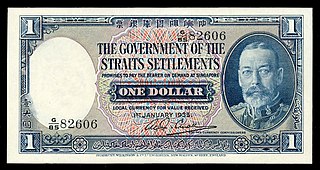
The Straits dollar was the currency of the Straits Settlements from 1898 until 1939. At the same time, it was also used in the Federated Malay States, the Unfederated Malay States, Kingdom of Sarawak, Brunei, and British North Borneo.
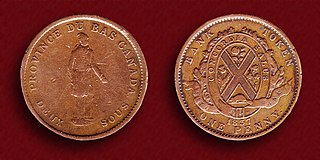
The pound was the currency of the Canadas until 1858. It was subdivided into 20 shillings (s), each of 12 pence (d). In Lower Canada, the sou was used, equivalent to a halfpenny. Although the £sd accounting system had its origins in sterling, the Canadian pound was never at par with sterling's pound.

Cash is a name for several historical currencies used in Asia. It is applied to units used in China, Vietnam, and of Madras and Princely state of Travancore in British India. It is also occasionally used to refer to the Korean mun and the Japanese mon.
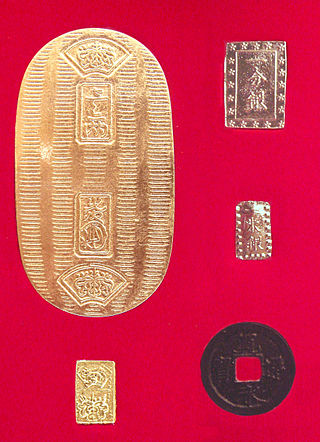
Tokugawa coinage was a unitary and independent metallic monetary system established by shōgun Tokugawa Ieyasu in 1601 in Japan, and which lasted throughout the Tokugawa period until its end in 1867.

Italy has a long history of different coinage types, which spans thousands of years. Italy has been influential at a coinage point of view: the medieval Florentine florin, one of the most used coinage types in European history and one of the most important coins in Western history, was struck in Florence in the 13th century, while the Venetian sequin, minted from 1284 to 1797, was the most prestigious gold coin in circulation in the commercial centers of the Mediterranean Sea.

The Indian 1-rupee coin (₹1) is an Indian coin worth one Indian rupee and is made up of a hundred paisas. Currently, one rupee coin is the smallest Indian coin in circulation. Since 1992, one Indian rupee coins are minted from stainless steel. Round in shape, the one rupee coins weighs 3.76 grams, has a diameter of 21.93-millimetre (0.863 in) and thickness of 1.45-millimetre (0.057 in). In independent India, one rupee coins was first minted in 1950 and is currently in circulation.

The Indian Temple tokens are token coins popular at temple and pilgrimage sites in India. They are also known as Rama-tankas, as several of them feature the Hindu deity Rama. Other names for these coins include ram-tenki, ram-tanka, and ram-darbar.



















